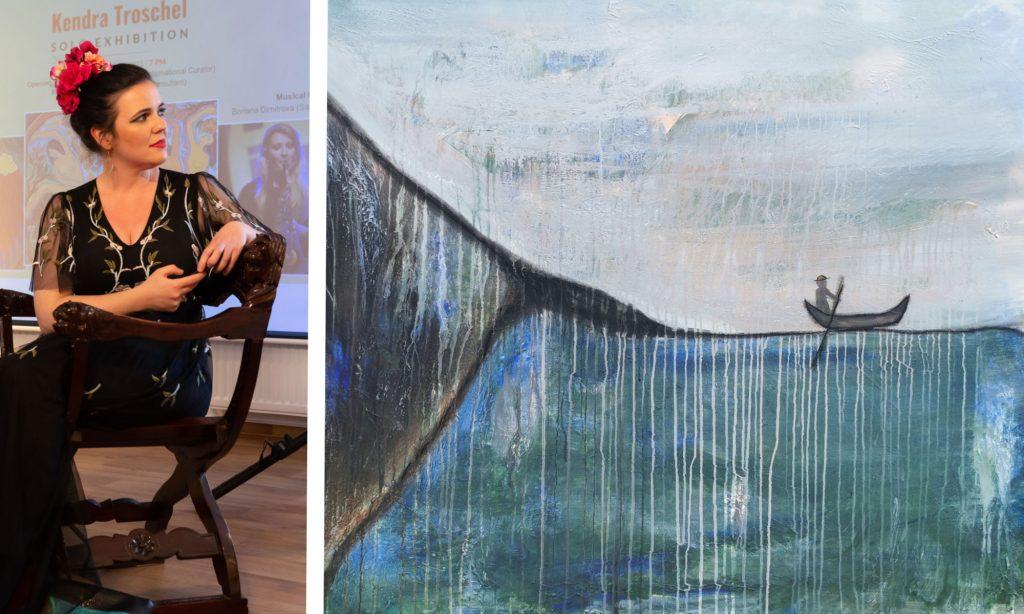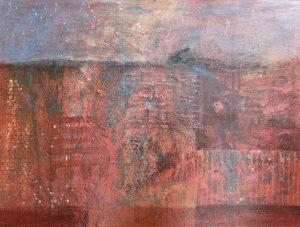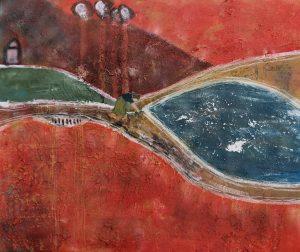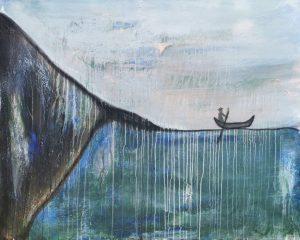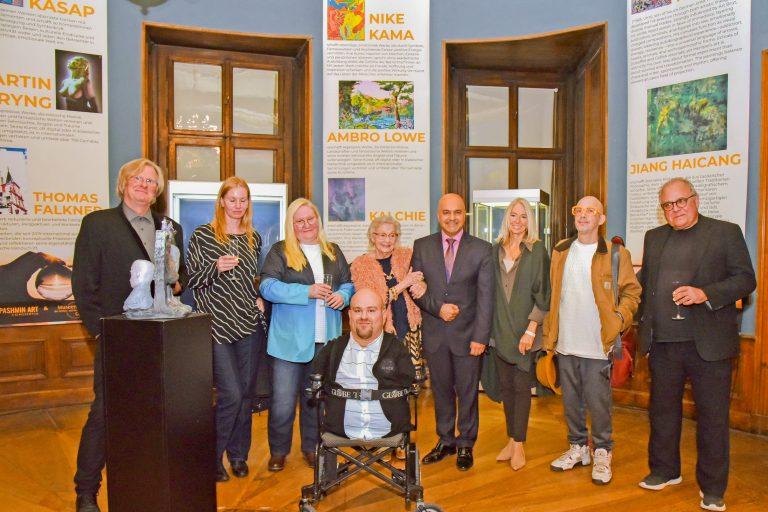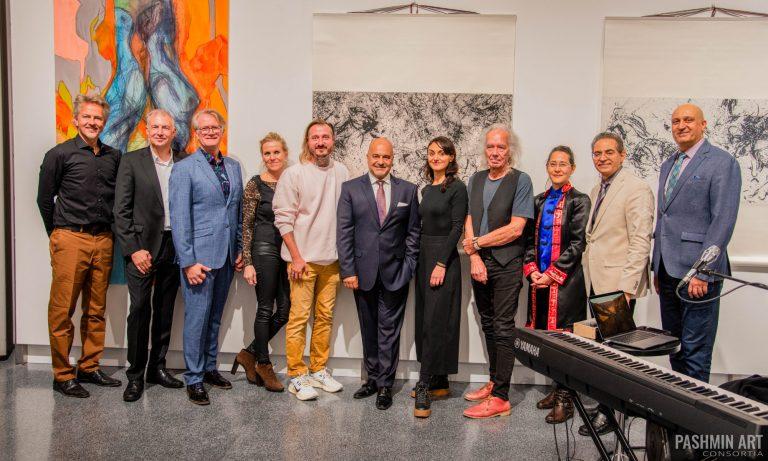Kendra Troschel’s art offers a deeply personal and universal exploration of spiritual journey, memory, and presence through vivid, textured paintings inspired by profound poetic sources. Her works Sohrab’s Gondola, Sohrab’s Mother, and Journey each channel themes of escape, maternal care, and the quest for meaning, inviting viewers to engage in a contemplative dialogue on life’s passage.
Kendra Troschel’s “Sohrab’s Gondola”: A Visual Journey Inspired by Sohrab Sepehri’s poem Beyond the Seas
Kendra Troschel’s Sohrab’s Gondola draws deeply from the contemplative spirit of Sohrab Sepehri’s poem Beyond the Seas (Posht-e Daryāhā), translating its themes of escape, spiritual quest, and renewal into a striking visual form. The painting depicts a solitary figure rowing a small boat across a vast expanse of water, framed by a large, solid landmass on the left and a pale, misty sky above.
The solid space represents the “strange land” Sepehri yearns to leave behind. Its dark, textured surface conveys confinement and stillness, embodying the poet’s words:
“I will build a Gondola, / I will cast it into the water. / I will distance myself from this strange land, / where there is no one to awaken the heroes / in the thicket of love.”
This landmass symbolizes the limitations and lifelessness of the current world, a place devoid of myth and vitality.
In contrast, the water’s deep blues and greens suggest movement, freedom, and transformation. The vertical white streaks evoke flowing currents, mirroring the poem’s recurring call to “row and row,” shedding attachments and pursuing spiritual awakening:
“I shall row and row / I will not grow attached to the blues / Nor to the mermaids who raise their heads from the water.”
Above, the soft, pastel sky symbolizes hope and transcendence, reflecting Sepehri’s vision of a divine city beyond the seas:
“Beyond the seas lies a city / Where windows open onto divine manifestation.”
Together, Troschel’s use of color, space, and form creates a meditative dialogue with Sepehri’s poetry—inviting viewers to join the timeless journey from confinement to liberation.
The poem ends with these lines:
“Poets are the heirs of water, wisdom, and light. / Beyond the seas, lies a city! / A Gondola must be built.”
Kendra Troschel’s “Sohrab’s Mother”: A Visual Meditation on The Water’s Footsteps
Kendra Troschel’s Sohrab’s Mother is a deeply evocative painting that visually embodies the spirit of Sohrab Sepehri’s long poem The Water’s Footsteps (Sedā-ye Pā-y-e āb), a humble and heartfelt ode dedicated to his mother and the quiet rhythms of daily life intertwined with nature.
The painting depicts a solitary figure bending over the earth beside a deep blue pond, surrounded by a vibrant landscape of warm reds and textured earth tones. This imagery resonates closely with Sepehri’s poetic lines:
“Down below / My mother was washing the cups / in the memory of river,”
capturing the reverence for maternal care and the intimate relationship between human life and the natural world.
Troschel’s use of rich, textured surfaces and bold, warm colors evokes the tactile, sensuous quality of the poem—its emphasis on the cyclical flow of life, memory, and the elemental presence of water. The painting’s curves and pathways suggest movement and the passage of time, mirroring the poem’s blending of personal memory with universal experience.
Sepehri’s verses describe life as a harmonious integration of the mundane and the mystical—where simple acts like washing or walking in the rain become spiritual rituals. Troschel’s visual interpretation honors this vision, inviting viewers to contemplate the sacredness found in everyday moments and the enduring presence of maternal love as a grounding force in a transient world.
Through this work, Troschel and Sepehri create a shared meditation on memory, nature, and the gentle yet profound legacy of a mother’s care—expressed through the flowing language of paint and poetry.
Kendra Troschel’s Journey: The Inner Pilgrimage and Its Universal Echoes
At the heart of Kendra Troschel’s painting Journey lies a deeply personal yet universal meditation on the nature of life as an ongoing spiritual pilgrimage. Through layered textures and muted hues, Troschel evokes the emotional landscape of the traveler’s soul—marked by movement, longing, and the search for meaning. Her work captures the tension between the physical and metaphysical paths we walk, suggesting that the essence of any journey lies not in reaching a destination, but in the transformative experience of moving through time and space.
Troschel’s Journey resonates profoundly with the themes explored in Sohrab Sepehri’s poem Mosāfer (Wayfarer). Sepehri’s poem weaves ancient mythologies and personal reflection into a sweeping narrative of the soul’s wanderings. It reveals the traveler’s realization that Ithaca—the ideal home or goal—is forever just beyond reach, emphasizing life’s perpetual unfolding and the spiritual growth found in continual seeking. Troschel’s painting visually manifests this philosophy, inviting viewers to reflect on their own paths of discovery and renewal.
This theme finds a contemporary echo in Emilio Estevez’s film The Way (2010), which chronicles a father’s physical and emotional journey along the Camino de Santiago. Like Sepehri and Troschel, the film underscores that the pilgrimage’s true meaning resides in the journey itself—the connections made, the healing embraced, and the wisdom gained—rather than in arriving at a final point.
Together, these three artistic expressions—Troschel’s visual meditation, Sepehri’s poetic soul journey, and Estevez’s cinematic pilgrimage—compose a powerful narrative about the human experience: that life is an endless journey where the path, not the destination, shapes who we are.
A Contemporary Echo: The Cinematic Pilgrimage of The Way
This timeless theme of spiritual journey and self-discovery also resonates in Emilio Estevez’s film The Way (2010), which chronicles a father’s transformative pilgrimage on the Camino de Santiago. Like Troschel and Sepehri, the film highlights that the true value lies in the journey—the healing, connections, and growth—rather than the arrival at a final destination.
Kendra Troschel’s evocative paintings, Sohrab Sepehri’s profound poetry, and The Way film form a rich conversation about life as an endless pilgrimage, reminding us that it is the journey itself that shapes our identity and meaning.
- References to Sohrab Sepehri’s poems are all translated by the author Davood Khazaie from Persian.
© Copyright of the text belongs to Dr. Davood Khazaie
LINKS:
